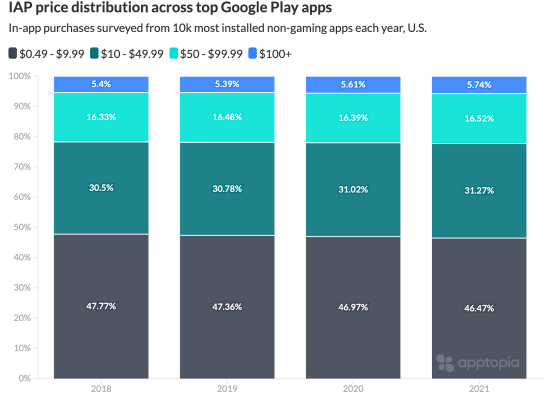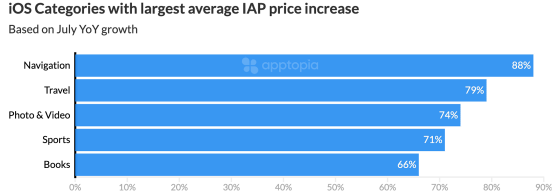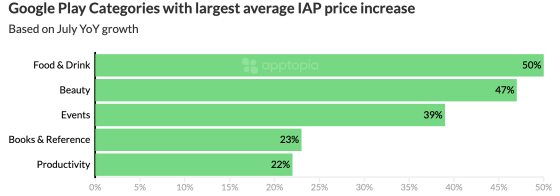It turns out that the average price of in-app billing in the iOS application has risen by 40% in one year, why on earth?

Applications for smartphones have a mechanism called 'in-
The average price of in-app purchases have increased 40% on iOS and 9% on Google Play since last year
https://blog.apptopia.com/app-store-iap-prices-are-increasing
Apple's in-app purchase prices jumped 40% year over year, likely tied to privacy changes | TechCrunch
https://techcrunch.com/2022/09/13/apples-in-app-purchase-prices-jumped-40-year-over-year-likely-tied-to-privacy-changes/
This is a graph comparing the transition of the average price of in-app purchases from July 2021 to July 2022 on the App Store for iOS and Google Play for Android. You can see that the average price has risen by about 40% in the App Store, while the increase in Google Play is about 9%.

With the US Consumer Price Index rising 8.5% from 2021 to 2022, it's a natural trend for the average price of in-app purchases to rise. However, the average price increase for iOS in-app purchases has been progressing before the severe inflation hit in 2022, and it is also puzzling that the rate of increase is different between Google Play and the App Store. Apptopia points out that there are factors other than inflation for these questions.
Apptopia points out that the reason for the increase in the average price of in-app purchases is the new privacy protection measure ``
It is reported that the introduction of ATT weakens the effectiveness of targeted advertising and increases the cost of acquiring new customers , hurting small and medium-sized enterprises. We are growing . As a result, national regulators have launched an investigation into ATT for alleged competition law violations.
Why is 'ATT' that Apple made it difficult for third parties to track users is being watched by regulatory authorities? -GIGAZINE

Apptopia speculates that the introduction of ATT may have increased the cost of acquiring new users, leading developers to raise the price of in-app purchases. To support this hypothesis, we compared the average price of in-app purchases (blue line) and advertising cost per install (green line) for iOS apps based on data from mobile marketing data analysis company Adjust . This is the graph I made. Indeed, increasing average in-app purchase prices for iOS apps appear to be correlated with increasing advertising costs per install.

In addition, it compares the average price increase of `` one-time in-app purchases '' (dark blue line) such as game skin purchases and `` continuous in-app purchases '' (light blue line) such as monthly or annual subscriptions. is below. The average price of one-time in-app purchases is up 36%, while the average price of subscriptions is up 19%. Based on this result, Apptopia said, ``Publishers are trying to offer value and attract customers longer to reduce acquisition costs.''

``If you think these price increases are too high, you need to remember that these price increases are not that high in absolute numbers,'' Apptopia said, adding a percentage of each price range for in-app purchases in iOS apps. We also present a graph showing the Looking at the graph below, which summarizes non-game apps with more than 10,000 installs, nearly 70% of the total will be ``0.49 to 9.99 dollars (about 70 to 1430 yen)'' even in 2021, and 50 dollars (about 7000 It can be seen that less than 6% of the total have implemented in-app purchases of ¥) or more.

This is a graph that summarizes the price range of in-app billing for Android apps on Google Play. Overall, it is higher than iOS apps, with less than 50% of apps priced between $0.49 and $9.99 in 2021, and more than 20% of apps priced at $50 or more.

Below is a graph showing the average price increase rate of in-app billing by app category. Apps on the App Store saw higher prices for navigation, travel, photos & videos, sports, books, and more, while apps on Google Play saw higher prices for food & drink, beauty, events, books & reference, productivity apps, and more. ... apparently ...


Related Posts:
in Software, Smartphone, Posted by log1h_ik







